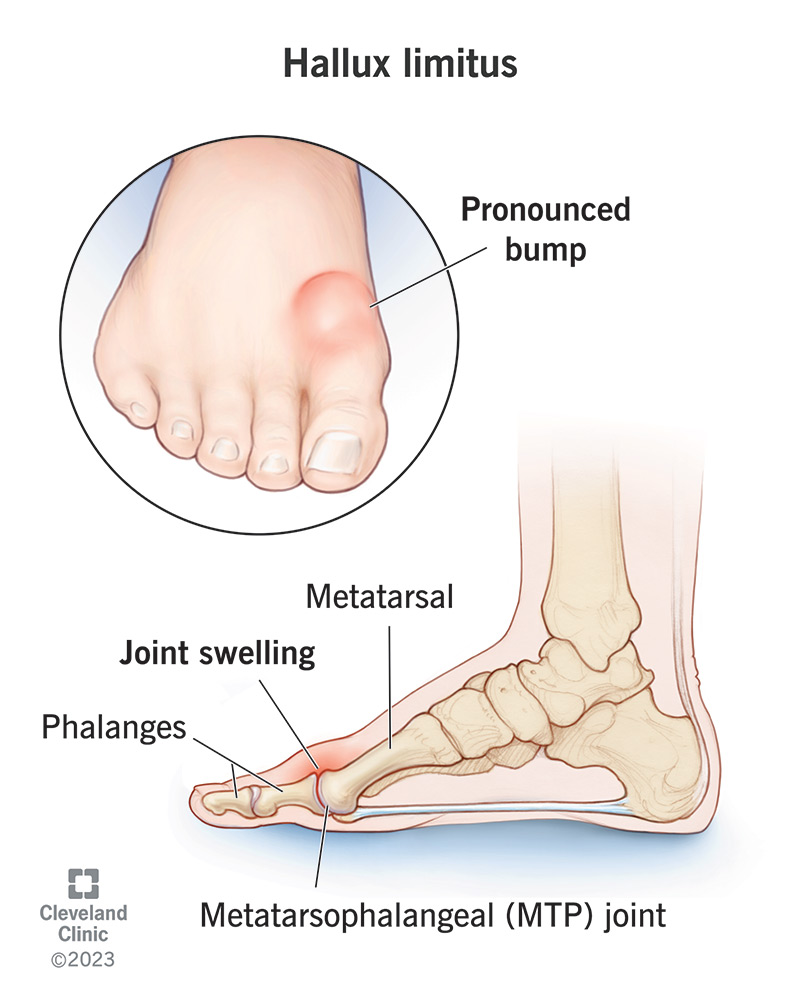Hallux limitus is a condition of the joint where your big toe meets your foot. Pain and stiffness in this joint make your big toe harder to bend. Treatments include rest, ice, anti-inflammatory drugs, proper footwear, orthotics, physical therapy and corticosteroid injections. Surgery is considered if other treatments don’t relieve your pain.
Advertisement
Cleveland Clinic is a non-profit academic medical center. Advertising on our site helps support our mission. We do not endorse non-Cleveland Clinic products or services. Policy

Hallux limitus is a condition in which the joint where your big toe meets your foot is painful and stiff. Hallux refers to your big toe. Limitus means limitation.
Advertisement
Cleveland Clinic is a non-profit academic medical center. Advertising on our site helps support our mission. We do not endorse non-Cleveland Clinic products or services. Policy
In the early stage of hallux limitus, you have limited flexibility in your big toe joint (called the first metatarsophalangeal joint). As your condition worsens, your toe joint becomes rigid (doesn’t move) and walking becomes very painful. At this stage, your toe joint condition is called hallux rigidus.
Functional hallux limitus is stiffness and limited range of motion in your big toe joint only when weight pressure is applied to your foot, like when you’re walking or stepping.
It can be tricky to discover if your provider isn’t familiar with this condition. This is because during a non-weight bearing examination, the motion in your big toe joint will be normal.
Hallux limitus affects an estimated 1 in 40 adults over the age of 50. It’s thought to begin in young adulthood. X-ray evidence shows joint changes in 10% of people between 20 and 34 years of age.
Hallux limitus symptoms, which can occur in one or both feet, are mild or even unnoticed in the beginning and gradually get worse.
Common signs and symptoms include:
Advertisement
Causes of hallux limitus include:
Your healthcare provider will ask you about your symptoms, ask if you’ve had any injuries to your foot or big toe, perform a physical exam of your foot or feet, check your toes flexibility and watch how you walk.
Your provider will order X-rays to evaluate the bones in your foot, confirm any bone spurs and loss of cartilage in your toe’s joints.
There’s a simple test to identify functional hallux limitus. While sitting with your foot free of shoe and sock and off the ground, your provider will place their index finger under your big toe and push your big toe up (toward your leg). Your toe should move back very easily. They’ll repeat the process, but this time your provider will place the palm of one hand under your foot and their thumb firmly pressed against your big toe joint. Then, your provider will again try to push your big toe up. If your toe doesn’t move much, you may have functional hallux limitus.
This test — with a hand under the sole of your foot and thumb pressing against your big toe joint — mimics weight-bearing as if you are walking. Having limited toe extension with this test indicates that motion with your full weight on your foot will be even more limited.
Your provider will first recommend conservative treatment options to reduce your pain and discomfort.
Recommendations include:
Advertisement
Functional hallux limitus is treated with:
Your provider will discuss the best treatment options for you.
Surgery is usually considered when hallux limitus progresses to hallux rigidus or when conservative treatments haven’t relieved your pain. However, if you have a foot deformity that’s making your hallux limitus worse or if you have severe symptoms, you and your surgeon will decide if surgery is an option.
Surgery options include:
Advertisement
Your healthcare provider may consider other specific surgical procedures. You and your provider will discuss if surgery is appropriate for your big toe and, if so, which procedure may give you the best outcome.
You can improve your chance of preventing further damage to your big toe if you see your healthcare provider as soon as you notice pain and discomfort in your big toe or your feet. Identifying hallux limitus early allows for treatment to begin early.
It depends on the cause and the treatment selected. Hallux limitus due to an injury can heal. On the other hand, hallux limitus due to arthritis may not go away and may progress to hallux rigidus.
Nonsurgical treatment can relieve your symptoms, but the pain might come back or get worse. Surgery may provide a permanent solution to pain and stiffness if you have hallux rigidus.
The cause of hallux limitus and treatment determine the length of your recovery.
If a high-impact activity or an injury is the cause, rest your foot often and avoid that activity until your joint or foot has recovered. Your provider will recommend how often to rest your foot and how long you should avoid certain activities.
If you had surgery, healing can take weeks and your return to usual activities can take a few months. Your provider will tell you specifically how long your recovery may take depending on the type of surgery you had and the condition of your big toe joint.
Advertisement
Hallux limitus is a condition that makes it difficult to bend your toe, which makes walking painful. It can worsen over time to the point that the joint in your big toe can no longer move. When this happens, the condition is called hallux rigidus. To slow the progression, make sure you have proper-fitting footwear, use orthotics as directed by your provider, take anti-inflammatory drugs and rest your feet. If you’re still in pain and walking is difficult, talk to your provider about corticosteroid shots and surgical options.
An aching foot or heel can bring your favorite activities to a halt. Cleveland Clinic’s foot pain experts are here to help you heal and get back on your feet.

Last reviewed on 07/20/2023.
Learn more about the Health Library and our editorial process.